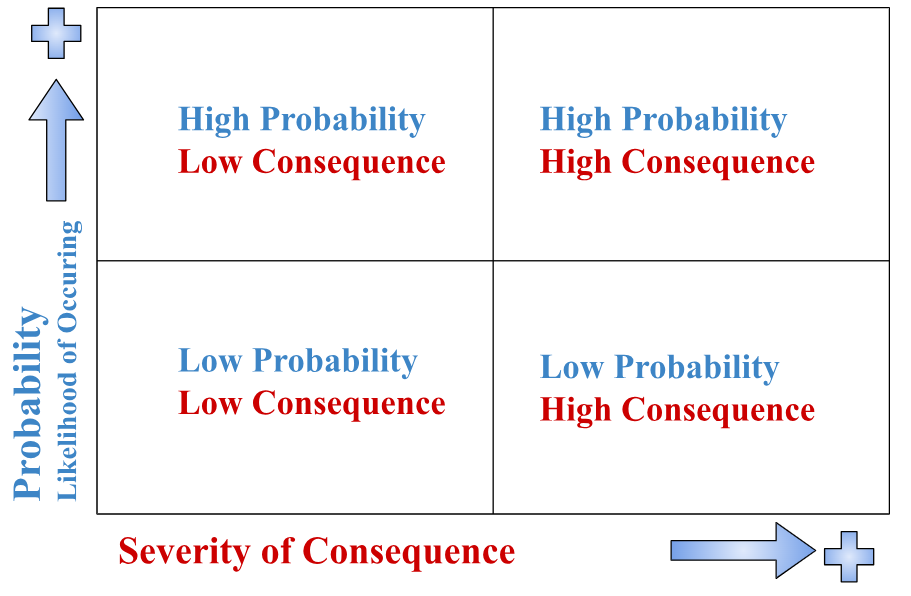Understanding Probability and Margins for Error
Learning Objective
Introduce the Probability Matrix as a fundamental decision-making tool and explore the concept of increasing error margins in outdoor risk environments.
Introduction
When we make a decision to proceed with an activity, whether consciously or unconsciously, we have made a decision about the probability of the activity ending without an incident and thus proceed. We have also at some point made a judgement about the severity of possible consequences and decided there are adequate mitigation parameters in place (such as safety systems, technical skills and equipment) to minimize those consequences.
In the context of outdoor leadership, where we have responsibility for the safety of others, these decisions and judgements need to be made at a conscious and calculated level. It requires a thorough cost-benefit analysis, weighing the value of the action or activity against its associated risks.
What to Consider?
Often, when considering an idea for an activity, our attention is drawn to the potential positive outcomes: the opportunities for learning, personal growth, excitement, and the creation of lasting memories. These positive aspects serve as strong motivators to move ahead with the activity. Yet, as leaders, it is crucial to strike a balance between these optimistic projections and a careful consideration of the potential negative outcomes. Viewing the situation through the lens of a Risk Manager becomes essential, contemplating the “what if things go wrong” aspects carefully before deciding to proceed.
As outdoor professionals, several key considerations must be taken into account when deciding to proceed with an activity. Here are a few crucial factors:
- Experience of the Leaders:
- Are the training, qualifications, and experience of the leaders aligned with the challenges of the activity?
- Does the activity fall within our defined Scope of Practice?
- Participant Skills and Preparedness:
- Are the participants adequately prepared and trained for the specific challenges of the activity?
- Time and Environmental Conditions:
- Consider the time of day, year, season, and conditions (temperature, weather, etc.).
- Noting that incidents in outdoor settings often occur late in the day, influenced by factors such as fatigue, hunger, lack of focus, decision fatigue, and the ‘barn door effect.’
- Time Allotted for the Activity:
- Can the activity be conducted safely within the allocated time constraints?
- Ego Considerations:
- Examine whether personal motivations, such as showcasing or testing personal skills, are influencing the decision-making process.
- Goals of the Trip/Learning Objectives:
- Ensure alignment between the intended goals of the trip or learning experience and the chosen activity.
- Inherent Risk in the Terrain:
- Evaluate the inherent risks presented by the terrain and whether they align with the capabilities of the group and leaders, scope of practice or accepted standards.
- Appropriate Equipment:
- Ensure that the equipment chosen is suitable for the specific terrain and conditions.
- Remoteness:
- Assess the distance from help in the event of an emergency. Consider the level of remoteness and its impact on response time and accessibility.
By carefully considering these factors, outdoor leaders can make informed decisions that prioritize safety and enhance the overall experience for participants.
Probability Matrix
The Probability Matrix serves as a simplified model and an effective decision-making tool. Its purpose is to guide us in determining whether to proceed with an activity, exercise caution, or implement additional mitigation strategies. This tool encourages thoughtful consideration of the potential undesired consequences associated with a chosen course of action. By applying the Probability Matrix, individuals can make more informed decisions in outdoor settings, taking into account various factors that may impact the safety and success of the activity.

In this quadrant, the Probability Matrix indicates a high likelihood of a mishap, but the consequence is low. Examples of activities falling into this category include consuming freshly cooked oatmeal while it is still too hot and risking burning one’s tongue. Similarly, some forest games may involve a high likelihood of minor incidents such as trips, scrapes, or bruises.

A shift in thinking needs to occur for this category specific to being in more remote areas, compared to being in an urban environment. In remote areas, as the probability of incidents, even minor ones increases there can be a compounding effect. If multiple group members suffer minor injuries, or multiple small incidents occur in a day, these can contribute to a chain of events that results in a more severe outcome (read more about “Lemon Theory” in the section on Risk Self Awareness).
In this quadrant, the likelihood of an incident occurring during the activity is high, and if such an incident were to happen, the consequences would also be high. Examples include hiking in the open during an active thunderstorm (risk of lightning strike), swimming in a fast-moving river without a personal flotation device (posing a risk of injury or drowning), and rock climbing without ropes or a safety system (increasing the risk of falling).
In most cases in guiding or instructing contexts, activities falling into this category tend to be avoided. An exception to this rule can be high-level professional trainings aimed at building specific expertise (e.g., military proficiency, rescue operations, high-angle rescue and some advanced guide training or exam programs), where the program goals may require more challenging terrain and activity levels, and more robust mitigation strategies are employed.
In this quadrant, the likelihood of an incident occurring is low or improbable, and if something does happen, the consequences are of little consequence. Examples include handling paper with bare hands (risk of a paper cut) or walking in the open wearing sunscreen in good weather (minor sun exposure).
While this quadrant might be considered ‘safe’, there is a potential drawback to consistently favouring activities in this category. Remaining exclusively in this low-consequence, low-likelihood quadrant might hinder personal or collective growth, depending on the purpose and goals of the program and the group. The perceived risk may also remain low here, preventing individuals and groups from facing challenges substantial enough to promote meaningful development or learning. Striking a balance between risk level and challenge is crucial to fostering growth and skill development in outdoor activities.
While certain outdoor activities may fall into the Low Probability-Low Consequence category, it’s crucial to recognize that even minor consequences can escalate into serious or life-threatening situations in remote areas. Operating in remote, or wilderness environments can amplify minor consequences into major and life threatening events due to the inability to get definitive medical care quickly, and lack of resources such as clean water, electricity or indoor shelter.
In this quadrant, the likelihood that an incident will happen is quite low or improbable; however, if something does occur, the consequences could be drastic and tragic. Examples of activities falling into this category include tsunamis, an experienced kayaker falling out of their kayak during a large cold water crossing, and safety equipment failures.
Examples of activities falling into this category include natural disasters, an experienced kayaker falling out of their kayak during a large cold water crossing, and safety equipment failures.
Incidents in this quadrant occur rarely and are unexpected or hard to predict; however, when they do happen the outcome can be severe or catastrophic. It can be difficult to completely understand, manage and fully mitigate the risks
Activity – Probability Matrix
Considering what we have discussed above, place the following decisions in the correct quadrant.
Understanding Your Margins for Error
As outdoor leaders, we frequently navigate complex decision-making in dynamic environments with limited feedback loops. Unlike activities with more direct feedback, such as bowling or playing darts, where adjustments can be made immediately after observing outcomes, decision-making in outdoor settings involves high stakes and often unclear feedback.
Creating wide margins for error provides room for small mistakes with lower consequences. This optimal zone of operation is characterized by having appropriate skills and equipment, sufficient time, and abundant resources, offering numerous options to manage risk effectively.
Conversely, situations with higher consequences and fewer options result in small margins. For instance, being a few miles from camp with tired and hungry participants, limited safe stopping points, and no option to backtrack can heighten risk due to the constrained choices available.
Next we will explore some strategies that support the creation of wide margins of error in our practice.

Control Levers of the Probability Matrix: Vulnerability and Exposure
Going back to the Probability Matrix we can also explore the concepts of Vulnerability and Exposure. Vulnerability is the propensity of a person/group to be harmed when exposed to a hazard. What you can add/change in a situation. You can change your vulnerability by having rescue resources, safety equipment, or by increasing skills through training/practice.
In the small margin example given above, a cold, tired, hungry person late in the day as the temperature is more likely to succumb to hypothermia if they fell in the water. You can ‘pull on the lever’ or manipulate the element of vulnerability by ensuring you have a supply of dry, warm clothing, hot liquids and and a practiced rescue technique at your disposal.
Exposure: is the presence of people/groups in systems, places, and settings that could be adversely affected by a hazard. I.e. an exposed stretch of coastline which is more susceptible to waves and wind vs a sheltered bay. There are ways to manipulate and mitigate your exposure – for example, paddling closer to shore or in a protected bay, or crossing via the shortest route vs taking a more extended crossing. In the winter mountains, travelling away from known avalanche terrain reduces your exposure to the risk of avalanche. These actions reduce your exposure to harm.
You can change your margins by pulling on the levers of Vulnerability and Exposure. This is an effective method of Managing Risk!
What can we do to change our margins?
Step 1: Access Your Margins
Ask: What is your current situation? This ties into Situational Awareness.
Step 2: Vulnerability/Exposure
Ask: What do you have control over to change your margins?
Step 3: Make A Plan
Exercise Shared Mental Modeling. Utilize the ‘team brain’ and ensure everyone is on the same page about the plan by using Closed Loop Communication.
Step 4: Execute The Plan
Execute the plan, monitoring the situation constantly and adjusting the plan accordingly, by continuing to practice Situational Awareness. as well as Workload Management.
Notice how these fit into the Risk Management Framework as conscious steps in managing risk!
Further Discussion
When considering the probability matrix, take some time to think about the following:
- What quadrant do many of our day to day activities fall under?
- How does this change when we are in an remote outdoor environment?
- What can we do to ensure that we are making sound decisions that do not put us and our groups into unnecessarily risky situations?
- Does being aware of a hazard (versus not being aware) change the likelihood or the severity?
- Events are not static on the quadrant: think about how consequences evolve based on preparedness, equipment, training and experience, exposure, and remoteness.

The tendency for individuals to races towards a goal when they believe it is near (like a horse seeing the barn doors after a day’s work), oblivious to any dangers around them.
the conscious knowledge of the immediate environment and all of the events happening in it
The process by which individuals within a group or team develop a common understanding of a situation, problem, or concept.
The use of effective communication to minimize misunderstandings and differing interpretations
Distributing tasks, resources, and responsibilities to individuals, or in order to optimize productivity while preventing overwhelm or burnout.



